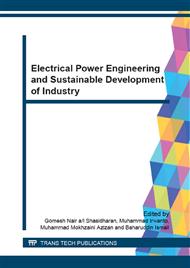p.516
p.523
p.530
p.535
p.541
p.549
p.554
p.559
p.563
A Small Scale Wireless Power Transfer
Abstract:
This paper describes a small scale energy transfer by using magnetic coil made with enamel coil, which is installed on the transceiver side and function generator and RF power amplifier are installed as source to generated signal, and on the receiving side is using an enamel coil materials as antenna. In this experiment obtained energy as it travels from the transceiver can be received at the receiver side without any media or cable, the principle of electromagnetic fields used in this experiment. Number of coil inductive coupling has been compare. Number of turn 4, efficiency 91 % at 0 cm with 4.55 volt and the lower efficiency 70% at 5 cm with 3.1 volt. And number of turn 8, efficiency 97.8% at 0 cm with 4.89 volt and the lower efficiency 70% at 5 cm with 3.50 volt
Info:
Periodical:
Pages:
541-545
Citation:
Online since:
September 2015
Keywords:
Price:
Сopyright:
© 2015 Trans Tech Publications Ltd. All Rights Reserved
Share:
Citation:


